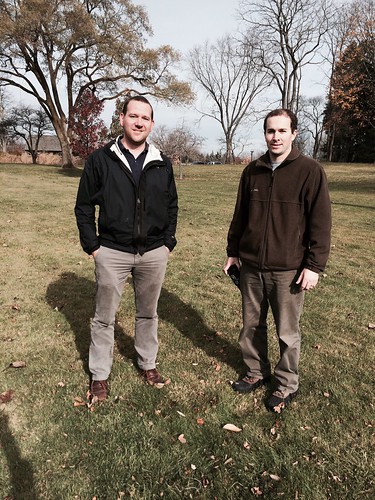Pegi Christiansen: Distance 4
This is the fourth in a series of blog posts by Pegi Christiansen, who is a Lynden artist in residence through October 2015. As part of her project, Distance, Pegi will accompany people, in groups of up to three, on their first trip to Lynden. She will pick them up, drive them out, take a walk with them, and bring them back. As part of the excursion, she will ask some questions about distance. If you are interested in participating in this aspect of Pegi's project, please call 414-446-8794 or email info@lyndensculpturegarden.org and mention you are interested in a “distance visit.”
These visits keep surprising me. On November 5, I picked up City of West Allis planners Shaun Mueller and Bart Griepentrog. During our two hours together that morning, I didn’t ask any of the questions from my list. We discussed distance in all sorts of new ways.

L-R: Bart Griepentrog and Shaun Mueller
I reside 23 miles away from Lynden in Greenfield. Since moving there in 2009, I spend more time in West Allis and find it intriguing. West Allis has more history and breadth than most Milwaukee suburban communities. We stopped in at Executive Director Polly Morris’s office and she agrees. She has a background in history and when she moved to Milwaukee in 1987 one of the first places she visited was the former Allis-Chalmers site in West Allis. One of the reasons I asked Bart and Shaun to come to Lynden with me is because, like Lynden, West Allis is an undiscovered treasure for too many people.
When I summarized the history of Lynden on the drive out, Bart remembered hearing that the sculptures at Lynden almost ended up at the Milwaukee Art Museum. We asked Polly about this. She said after Jane Bradley Pettit died in 2001, her descendants debated donating the sculptures to the MAM. The family decided to open Lynden to the public instead.
We also spoke with Polly about former artist in residence Roy Staab, who lives in West Allis. For the city’s 100th anniversary in 2006, the mayor commissioned Roy to create Fountain in the Sky at the West Allis City Hall. Roy made the temporary sculpture out of weeds bound with jute and plastic cording. As we started our walk, I suggested West Allis could designate a permanent site where Roy could create a series of temporary installations.
I asked Shaun and Bart about ways in which, as planners, they think about distance. It turns out they are thinking about distance all the time.
--How far do people live from shopping, restaurants, and entertainment?
--How much time does it take for people to walk or drive to various locations?
--Potential employers want to know how far away potential employees live and whether it is easy to get to the airport.
Distance can be political as well as geographical. In the four-county Milwaukee area, some people want distance from the city, which increases segregation. West Allis needs to alert citizens about certain land use changes happening in their neighborhood, but only if they live within 200 feet. If you live outside this arbitrary zone, you are not directly notified.
The final stop on our walk was by my favorite cluster of permanent sculptures. In the area just south of the bridge are two Linda Howard sculptures (I enjoy watching the way they interact with the sun), Isaac Witkin’s Kumo (it makes me laugh), and Deborah Butterfield’s Hara (the horse looks like it is made out of wood, but it’s really bronze).
It turns out Shaun and Bart care about clusters, too. People tend to come to West Allis for one thing--perhaps the farmers market or the Wisconsin State Fair. West Allis wants to encourage people to explore a cluster of things. For example, after shopping at the West Allis Farmers Market, open May through November at 65th and National, what would it take to convince a person to check out Oniomania, a funky gift shop a block away at 6430 W. National?
On our way back to the parking lot, Bart challenged all my typical thinking about noise. Although Lynden is pastoral and serene, the sound of cars on Brown Deer Road, a state highway, is audible. Bart said that Cathedral Square, a one-block park in downtown Milwaukee, is actually quieter. “This is because people downtown have alternatives to using cars,” Bart explained. “They can walk or bike, and the cars downtown are driving 25 miles an hour and have to stop about every three blocks for lights.” Bart is frustrated by all the commuters on Brown Deer Road who, in order to escape the city to reach the small communities where they live, in Menomonee Falls or Germantown, destroy the calm for everyone in between.
- Willy's blog
- Login to post comments
